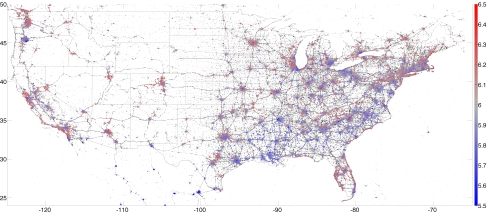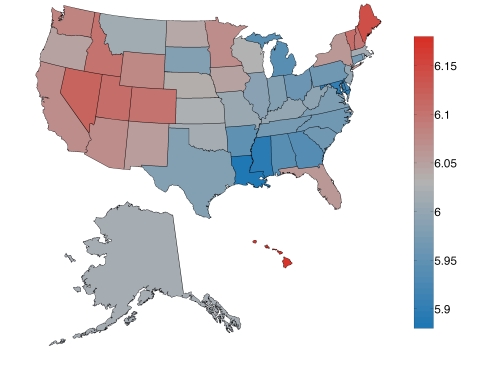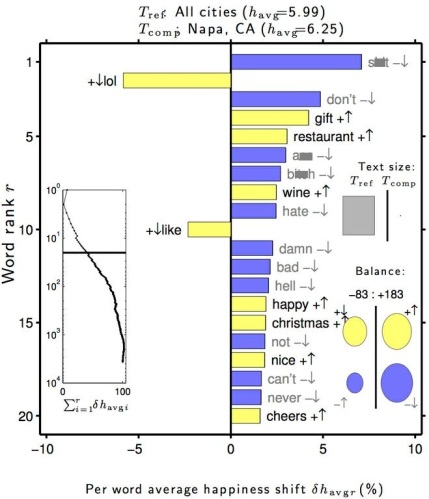(Update: this work is now published at PLoS ONE)
Is Disneyland really the happiest place on Earth?* How happy is the city you live in? We have already seen how the hedonometer can be used to find the happiest street corner in New York City, now it's time to let it loose on the entire United States.
We plotted over 10 million geotagged tweets from 2011 (all our results are in this paper, also on the arxiv), coloring each point by the average happiness of nearby words (detail on how we calculate happiness can be found in this article published in PLoS ONE):
As well as cities and the roads between them, we can make out many regions of higher and lower happiness, even within individual cities. As an example, check out this tweet-generated map of the city of Chicago:
Tweet-generated map of Chicago. Click to enlarge.
Notice the striking contrast between the relatively happy Central/North Side of the city, and the sadder South Side. You can also find a few airports in this map, and if you look very closely you might even be able to pick out happy and sad terminals!
To quantify this variation in happiness a bit better, let's look at the average happiness of each state:
Southern states tend to produce sadder words than those in northern New England or out west. Hawaii emerges as the happiest state and Louisiana as the saddest, due to relative differences in the frequencies of happy and sad words used in each state. Here at onehappybird, we characterize such differences by "word shifts", which are basically word clouds for grown-ups. You can find examples of these, as well as the full list of the average happiness of each state, here (page best viewed using Google Chrome).
Zooming in further to the level of cities, we produced a similar list for 373 cities in the lower 48 states (you can find the full list, as well as maps and word shifts for each city, here). With a score of 6.25, we found the happiest city to be Napa, CA, due to a relative abundance of such happy words as "restaurant", "wine", and even "cheers", along with a lack of profanity.
At the other end of the spectrum, we found the saddest city to be Beaumont, TX, with a score of 5.82. In general, cities in the south tended to be less happy than those in the north, with a major contributing factor being the relative abundance of profanity used in those cities.
We can go even further than this, and group cities by similarities in word usage. Each square in the heatmap below represents the similarity (Spearman correlation for you mathematically minded onehappybird watchers) between word distributions for the largest cities in the US. Red squares mean that the corresponding cities use words in a similar fashion, while blue means that those cities tend to use different types of words with respect to each other. The colors in the tree diagram at the top signify clusters of cities exhibiting similar word usage (below a certain threshold).
As we might expect for two cities that are geographically nearby, New Orleans and Baton Rouge are clumped together at the bottom right of the figure. On the other hand, New York and Seattle get clumped together as well, suggesting that similarities in language depend on more than just geographical proximity.
You can find more information about happiness and cities, as well as details on the methods used to produce these results, in our arxiv research article. In our next post, we'll look at how these results are related to various underlying socioeconomic characteristics of cities. What makes a city happy or sad? Can we use Big Data to predict future changes in the demographics, health, or happiness of a city? How does happiness relate to the food you eat?
*By the way, to answer the question at the start of this post: According to this analysis Disneyland is not the happiest place on Earth; it isn't even the happiest place in Southern California! See if you can find it in this tweet-generated map of LA! Or find your city here.






